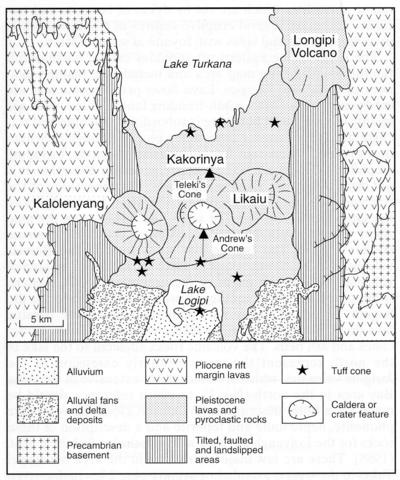stripes
The Barrier volcano stands at the southern end of Lake Turkana and is so named because it separates the lake from the Suguta valley, the site of a former lake to the south. It forms an east-west-trending ridge 20 km in length and 15 km wide. Dodson (1963) considered that the volcanic rocks were emplaced in four phases while Williams et al. (1984) distinguished eight events in its evolution. Dunkley et al. (1993) demonstrate that Barrier is a composite structure of four distinct volcanic centres which, from west to east, are Kalolenyang, Kakorinya, Likaiu West and Likaiu East. They comprise a wide spectrum of lavas including basanite, basalt, hawaiite, mugearite, benmoreite, trachyte and phonolite. Trachytic pyroclastic deposits cover much of the western slopes of Kakorinya and the summit of Likaiu West and Dunkley et al. (1993) suggest an overall ratio of trachyte to basalt of about 10:1. The foundation rocks of the volcano are exposed in the adjacent rift walls and are essentially basalts. The centres of Kalolenyang and Likaiu East contain extensive areas of trachyte lavas and pyroclastic flows while to the east of the summit of the former is a 50 m deep and 2 km diameter crater. Kalolenyang also has extensive areas of mugearite and basalt. Likaiu West is not so well defined but there are numerous scoria cones on the upper slopes which were the source of extensive flows of basalt and hawaiite that mantle the northern and southern flanks. There are also a series of lava domes and short viscous flows across the summit area which comprise benmoreite, trachyte and phonolite. Kakorinya forms the central part of the complex and is the youngest. It has a well-preserved, unbreached circular summit crater which is partly filled with lavas and pyroclastic deposits. Extensive basalt lava fields cover the northern and southern slopes of Kakorinya and include the scoria cones known as Teleki’s and Andrew’s (Lugugugut) volcanoes. These centres are clearly seen on a colour air photograph reproduced by Dunkley et al. (1993, Fig. 11.1). Teleki’s volcano has erupted on several occasions in recent times, the flows extending northwards to Lake Turkana, while flows from Andrew’s cone extend southwards as far as Lake Logipi. Kakorinya includes several groups of trachyte lavas and pyroclastic rocks, basalts, hawaiite, mugearite and three large phonolite domes, which are located on the northern rim of the caldera. Detailed accounts of all the major volcanic units will be found in Dunkley et al. (1993), with a little petrographic detail. A phonolite described by Smith (1938) contains phenocrysts of twinned anorthoclase and microphenocrysts of nepheline, sodalite, aegirine-augite and probable aenigmatite in a groundmass of the same minerals plus aegirine. A specimen described by Dodson (1963) is characterised by abundant analcime but apparently lacks nepheline. The trachytes contain rare alkali feldspar phenocrysts set in a trachytic matrix of aegirine-augite, sodic amphibole (?katophorite), and in some rocks aenigmatite and analcime. Nine rock analyses of Barrier rocks are available (see references cited by Williams et al., 1984) and Brown and Carmichael (1971) give chemical data for pyroxenes and some opaque phases. Although they do not give analyses Dunkley et al. (1993) present a number of chemical plots, e.g. TAS and normative Ol-Ne-Q, illustrating the general trends of the Barrier rocks; these authors also include a full colour, 1:50,000 geological map of the complex and a number of aerial photographs.
BROWN, F.H. and CARMICHAEL, I.S.E. 1971. Quaternary volcanoes of the Lake Rudolf region. Lithos, 4: 305-23.DODSON, R.G. 1963. Geology of the South Horr area. Report, Geological Survey of Kenya, 60: 1-53.DUNKLEY, P.N., SMITH, M., ALLEN, D.J. and DARLING, W.G. 1993. The geothermal activity and geology of the northern sector of the Kenya rift valley. British Geological Survey, Research Report. International Series SC/93/1: 1-185.SMITH, W. C. 1938. Petrographic description of volcanic rocks from Turkana, Kenya Colony, with notes on their field occurrence from the manuscript of Mr. A.M. Champion. Quarterly Journal of the Geological Society of London, 94: 507-53.WILLIAMS, L.A.J., MACDONALD, R. and CHAPMAN, G.R. 1984. Late Quaternary caldera volcanoes of the Kenya Rift Valley. Journal of Geophysical Research, 89: 8553-70.

